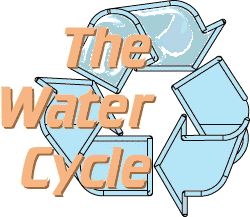
Introduction
Scientific Concepts

Scientific Concepts
There are six important processes that make up the water cycle. These are:
Evaporation
Evaporation is the process where a liquid, in this case water, changes from its liquid state to a gaseous state. Liquid water becomes water vapor. Although lower air pressure helps promote evaporation, temperature is the primary factor. For example, all of the water in a pot left on a table will eventually evaporate. It may take several weeks. But, if that same pot of water is put on a stove and brought to a boiling temperature, the water will evaporate more quickly.Condensation
During the water cycle some of the water in the oceans and freshwater bodies, such as lakes and rivers, is warmed by the sun and evaporates. During the process of evaporation, impurities in the water are left behind. As a result, the water that goes into the atmosphere is cleaner than it was on Earth.
Condensation is the opposite of evaporation. Condensation occurs when a gas is changed into a liquid. Condensation occurs when the temperature of the vapor decreases.PrecipitationWhen the water droplets formed from condensation are very small, they remain suspended in the atmosphere. These millions of droplets of suspended water form clouds in the sky or fog at ground level. Water condenses into droplets only when there are small dust particles present around which the droplet can form.
When the temperature and atmospheric pressure are right, the small droplets of water in clouds form larger droplets and precipitation occurs. The raindrops fall to Earth.Surface RunoffAs a result of evaporation, condensation and precipitation, water travels from the surface of the Earth goes into the atmosphere, and returns to Earth again.
Much of the water that returns to Earth as precipitation runs off the surface of the land, and flows down hill into streams, rivers, ponds and lakes. Small streams flow into larger streams, then into rivers, and eventually the water flows into the ocean.InfiltrationSurface runoff is an important part of the water cycle because, through surface runoff, much of the water returns again to the oceans, where a great deal of evaporation occurs.
Infiltration is an important process where rain water soaks into the ground, through the soil and underlying rock layers. Some of this water ultimately returns to the surface at springs or in low spots downhill. Some of the water remains underground and is called groundwater.TranspirationAs the water infiltrates through the soil and rock layers, many of the impurities in the water are filtered out. This filtering process helps clean the water.
One final process is important in the water cycle. As plants absorb water from the soil, the water moves from the roots through the stems to the leaves. Once the water reaches the leaves, some of it evaporates from the leaves, adding to the amount of water vapor in the air. This process of evaporation through plant leaves is called transpiration. In large forests, an enormous amount of water will transpire through leaves.